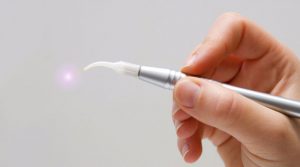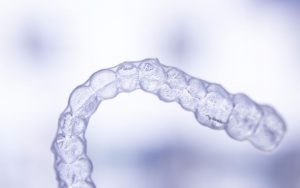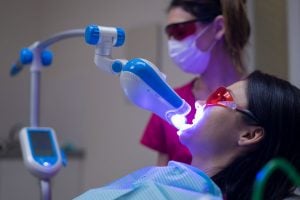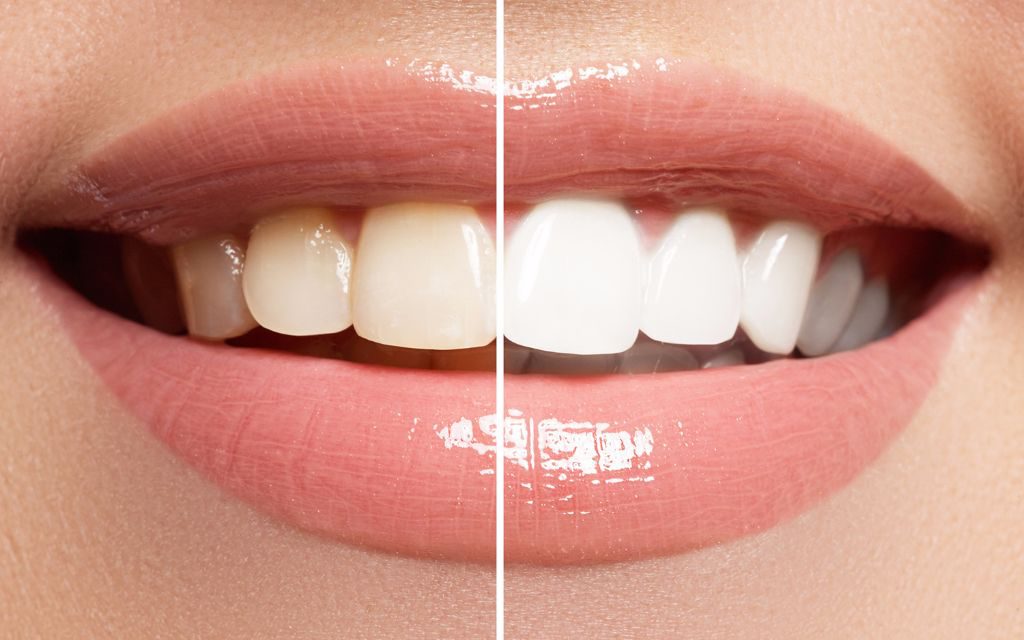If you want beautiful pearly white teeth and you’re ready to move beyond the minimal amount of whitening provided by whitening toothpastes and over-the-counter strips, it’s time to step it up to professional teeth whiteners. But when you head to your dental office, you have some important decisions to make.
Should you choose professional teeth whitening via bleaching trays, or should you pay for laser teeth whitening? It’s a choice that has a big effect on your wallet as well as your smile. Make sure you understand each method and its pros and cons and make an informed choice that’s right for you and your budget.
Table of Contents
- How Does Bleaching Work?
- How Does Laser Whitening Work?
- Pros and Cons of Bleaching
- Pros and Cons of Laser Whitening
- Bottom Line: Bleaching vs. Laser Whitening
How Does Bleaching Work?
When you have your teeth bleached, the dentist applies a hydrogen peroxide or carbamide peroxide paste to your teeth. This peroxide paste is placed in bleaching trays, which apply the paste where you want it, on the enamel of your teeth.
Once in place, the peroxide paste releases molecules of oxygen that work their way into the discolored sections of your tooth enamel and break down the discolorations and stains chemically.
Typically, your dentist will give you a fitted bleaching tray, and you’ll sleep with it in place or wear it from 30 minutes to 2 hours. You continue this daily for anywhere from a few days to a few weeks, depending on how much bleaching your teeth need.
How Does Laser Whitening Work?

Remember how peroxide paste breaks down stains on your teeth’s enamel when you use bleaching trays? Well, you’re still using bleaching trays when you opt for laser whitening. All the lasers do is heat the oxygen in the peroxide paste to speed up the breakdown of the discoloration.
The dentist applies either a carbon dioxide (CO2) or an argon laser to the bleaching trays to hasten the chemical reaction that the bleach has already started. By speeding up the bleaching process, laser teeth whitening may be able to remove stains on your teeth with a series of 30-minute sessions, which are typically spread out at a rate of one every 10 days or so.
While some people choose laser whitening to avoid having to sleep with bleaching trays in their mouths, in some cases, dentists may choose to augment laser whitening with nightly-use bleaching trays, wiping out this potential advantage.
Pros and Cons of Bleaching

Bleaching is the simpler of the two types of professional teeth whitening. Given that both processes achieve the same results, you
have to think about other factors when deciding which you prefer. Consider these pros and cons while making your choice.
Pros of Bleaching
- Because your dentist gives you individually created bleaching trays, they match your unique dental structure exactly, so the bleaching paste ends up precisely where you need it most.
- Since you bleach your teeth while you sleep, you don’t have to take time out of your schedule for the process. You can actually multi-task while you sleep!
- If you use the stronger bleaching solution for the shorter time periods (30 minutes or less), you may experience less sensitivity.
- The bleaching trays are thin, clear, and not invasive, making them comfortable for most people to wear.
- Bleaching costs far, far less than laser whitening. In fact, the overall cost is about 90 percent less than the typical costs associated with laser whitening.
- Annual maintenance for bleaching runs about $40 (only 3 percent of the costs of laser whitening), which is the cost of the carbamide peroxide gel syringes needed for a year’s worth of maintenance. Because your bleaching trays can be reused safely and successfully for two to five years, you don’t incur extra expenses for new equipment.
Cons of Bleaching
- Bleaching requires more applications than does laser teeth whitening (though in most cases, you’ll reach your desired level of whiteness more quickly with bleaching, due to the gaps required between laser whitening treatments).
- Some people aren’t comfortable using the bleaching trays or aren’t willing to wait a few weeks to see results.
Pros and Cons of Laser Whitening

Like bleaching, laser whitening also has many pros and cons to consider before you commit to it.
The Pros of Laser Whitening
- Laser whitening can usually be completed with a total of two to four treatments (though you may require more if your teeth are extremely discolored).
- Each whitening session takes only 15 to 60 minutes.
- You’re likely to see some results right away, which can be encouraging. In addition, the immediate results may be more dramatic than they are typically with bleaching trays.
- If you discover that your teeth are sensitive to the use of lasers, you can take comfort knowing your treatments are performed under medical supervision to minimize any potential negative reactions or discomfort.
The Cons of Laser Whitening
- SENSITIVITY!
- Although the big plus of laser whitening is its speed, you actually have to spread the sessions out, with a gap of 10 to 14 days between each one. This means it could actually take up to two months to complete your treatment.
- You have to take time out of your day to go to the dentist’s office for each treatment. If you have a complicated schedule or are unable to take time off from work as easily as you would like, this could mean delaying your treatments even further.
- You have to watch your diet for the first 48 hours after a teeth whitening session — and some dentists may ask you to be careful for a full week. Eating colored foods — think coffee, tea, wine, red meat, almost all fruits, tomato sauce, soy sauce, and chocolate — can re-stain the teeth during this sensitive period. If sticking to all-white food is easy for you, this may not be an issue. Otherwise, you may have to drink everything through a straw or even put petroleum jelly on your teeth to try to protect them.
- In many cases, dentists use a peroxide mixture that contains 35 to 44 percent hydrogen peroxide — far stronger than the 10-percent solutions that are approved by the American Dental Association for use in bleaching trays. While this concentration may not be unsafe, more studies are needed.
- Some people learn their teeth are sensitive to the high concentration of peroxide used in laser whitening treatments, making the treatments potentially painful. People with this sensitivity tend to experience a feeling like electric shock in their teeth toward the end of each treatment.
- The possibility that lasers may damage tooth pulp has not been ruled out. Some dentists believe lasers can erode the tooth’s enamel and weaken tooth pulp, perhaps permanently.
- You don’t avoid bleaching trays when you opt for laser teeth whitening. Your dentist is likely to send you home with bleaching trays (not custom-fit to your mouth) that you must use with peroxide gel every day between your laser treatments.
- The major issue for most people: Laser teeth whitening is very expensive. You should expect to pay at least $1,500 per year for the initial whitening and for the annual maintenance required. Because teeth whitening is a cosmetic procedure, no dental insurance will pay for it, so that money comes out of your own pocket.
The Bottom Line: Bleaching Vs. Laser Whitening

As you make your decision between bleaching and laser whitening, here’s the most important thing to remember: Laser whitening is bleaching, but on a slightly different timetable. In fact, the ADA has noted that studies show no long-term benefit for laser whitening when compared to bleaching.
Another consideration is that teeth whitening doesn’t work for everyone. Some people have teeth that are darker as a result of their genetic makeup. In these cases, all the whitening in the world may not make an obvious difference. While many people see an enormous difference in their appearance as a result of whitening (regardless of the method chosen), people who aren’t aware yet whether their teeth will respond to whitening may not want to make a huge investment in the process right up front.
If you’re like many people, the bottom line in the bleaching vs. laser teeth whitening debate is just that: the bottom line of your budget. Because laser teeth whitening is so expensive, it puts a stress on many people’s wallets. The other significant factor is the pain associated with laser teeth whitening or in-office teeth bleaching systems. At home whitening trays are much more tolerable when considering teeth sensitivity and can be controlled easily by removing the trays and placing a desensitizing paste in the tray and reapplying to the teeth.
Ultimately, this decision is one you should make in conjunction with your dentist, keeping your budget and your timetable in mind. While ads for laser teeth whitening may tempt you to break out your credit card, take the time to sort through the facts and advantages of both processes before coming to a final decision.
Dr. Michael does not support laser teeth whitening at this time.
- Dental Implant Pros and Cons - August 26, 2023
- Receding Gums Stages - August 12, 2023
- When Is It Too Late for Gum Grafting? - July 8, 2023


